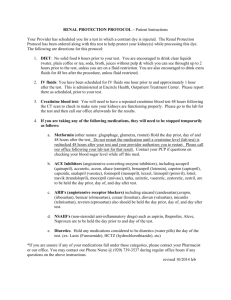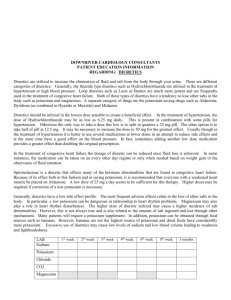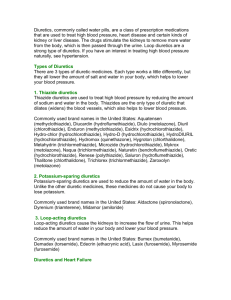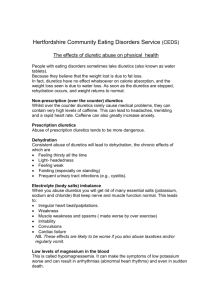http://www.uobabylon.edu.iq/eprints/publication_3_818_374.pdf
advertisement
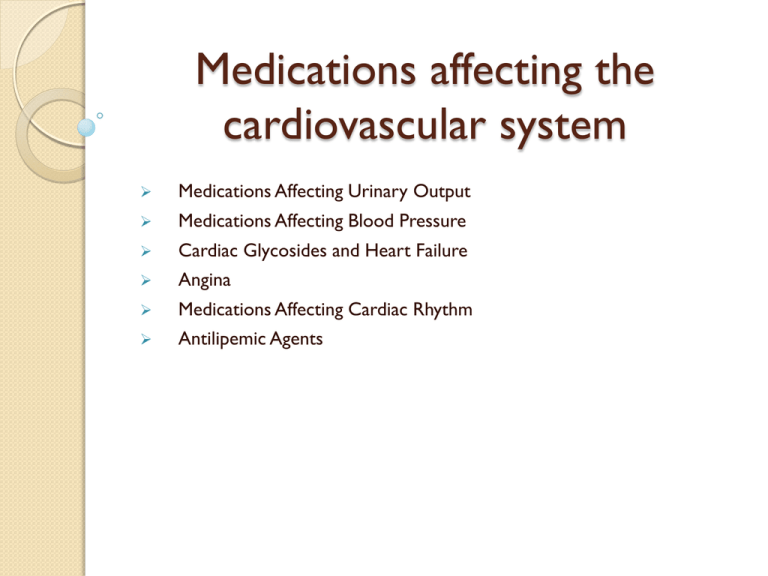
Medications affecting the cardiovascular system Medications Affecting Urinary Output Medications Affecting Blood Pressure Cardiac Glycosides and Heart Failure Angina Medications Affecting Cardiac Rhythm Antilipemic Agents Medications Affecting Urinary Output Overview Indications for medications that affect urinary output include management of blood pressure, excretion of edematous fluid related to heart failure, kidney and liver disease, and prevention of renal failure. Medications include high-ceiling loop diuretics, thiazide diuretics, potassiumsparing diuretics, and osmotic diuretics. High Ceiling Loop Diuretics Select Prototype Medication: furosemide (Lasix) Other Medications: Ethacrynic acid (Edecrin) Bumetanide (Bumex) Torsemide (Demadex) Expected Pharmacological Action High ceiling loop diuretics work in the ascending limb of loop of Henle to: 1. Block reabsorption of sodium and chloride and to prevent reabsorption of water 2. Cause extensive diuresis even with severe renal impairment Therapeutic Uses High ceiling loop diuretics are used when there is an emergent need for rapid mobilization of fluid such as: 1. Pulmonary edema caused by heart failure. 2. Conditions not responsive to other diuretics such as edema caused by liver, cardiac, or kidney disease; hypertension. Therapeutic Uses These medications may also be used to treat hypercalcemia related to kidney stone formation. Route of administration Oral, IV, IM. Side/adverse effects Side/adverse effects Contraindications/Precautions Pregnancy Risk Category C Avoid using these medications during pregnancy unless absolutely required. Use cautiously in clients who have diabetes and/or gout. Interactions Nursing Administration Obtain the client’s baseline data to include orthostatic blood pressure, weight, electrolytes, and location and extent of edema. Weight clients at the same time each day; usually upon awakening. Monitor the client’s blood pressure and I&O. Avoid administering the medication late in the day to prevent nocturia. Usual dosing time is 0800 and 1400. Administer furosemide orally, IV bolus dose, or continuous IV infusion. Infuse IV doses at 20 mg/min or slower to avoid abrupt hypotension and hypovolemia. If potassium level drops below 3.5 mEq/L, clients should be placed on a potassium supplement. Nursing Administration If the medication is used for hypertension, teach clients to self-monitor blood pressure and weight by keeping a log. Advise clients to get up slowly to minimize postural hypotension. If faintness or dizziness occurs, instruct clients to sit or lie down. Teach clients to report significant weight loss, lightheadedness, dizziness, GI distress, and/ or general weakness to the provider. Encourage clients to consume foods high in potassium, such as avocados and strawberries. Instruct clients with diabetes to monitor for elevated blood glucose levels. Instruct clients to observe for signs of low magnesium levels such as muscle twitching and tremors. Nursing Evaluation of Medication Effectiveness Depending on therapeutic intent, effectiveness may be evidenced by: Decrease in pulmonary or peripheral edema Weight loss Decrease in blood pressure Increase in urine output Thiazide Diuretics hydrochlorothiazide (Hydrodiuril) Other Medications: Chlorothiazide (Diuril) Methyclothiazide (Enduron) Thiazide-type diuretics: indapamide (Lozide, Lozol) chlorthalidone (Hygroton) metolazone (Zaroxolyn) Expected Pharmacological Action Thiazide diuretics work in the early distal convoluted tubule to: Block the reabsorption of sodium and chloride, and prevent the reabsorption of water at this site Promote diuresis when renal function is not impaired Therapeutic Uses Thiazide diuretics are often the medication of first choice for essential hypertension. These medications may be used for edema of mild-to-moderate heart failure and liver and kidney disease. Side/Adverse Effects Contraindications/Precautions Thiazide diuretics are Pregnancy Risk Category B. Avoid use during pregnancy and lactation. If a thiazide diuretic is indicated, advise clients not to breastfeed. Interactions Nursing Administration Chlorothiazide may be administered orally and IV, all others can only be given orally. Obtain the client’s baseline data to include orthostatic blood pressure, weight, electrolytes, and location and extent of edema. Monitor the client’s potassium levels. Nursing Administration Instruct clients to take the medication first thing in the morning; if twice-a-day dosing is prescribed, be sure the second dose is taken by 1400 to prevent nocturia. Encourage clients to consume foods high in potassium and maintain adequate fluid intake (1,500 mL per day, unless contraindicated). If GI upset occurs, clients should take the medication with or after meals. Alternate-day dosing can decrease electrolyte imbalances. Nursing Evaluation of Medication Effectiveness Depending on therapeutic effectiveness may be evidenced by: Decrease in blood pressure Decrease in edema Increase in urine output intent, Potassium-Sparing Diuretics Select Prototype spironolactone (Aldactone) Other Medications: triamterene (Dyrenium), amiloride (Midamor) Medication: Expected Pharmacological Action Potassium-sparing diuretics block the action of aldosterone (sodium and water retention), which results in potassium retention and the secretion of sodium and water. Therapeutic Uses Potassium-sparing diuretics are combined with other diuretics for potassium-sparing effects. Potassium-sparing diuretics are used for heart failure. In primary hyperaldosteronism, potassium-sparing diuretics block actions of aldosterone. Route of administration Oral Side/Adverse Effects Contraindications/Precautions Do not administer to clients who have hyperkalemia. Potassium-sparing diuretics are contraindicated in clients who have severe renal failure and anuria. Interactions Nursing Administration Obtain the client’s baseline data. Monitor the client’s potassium levels regularly. Can only be given orally. Teach clients to avoid salt substitutes that contain potassium. Teach clients to self-monitor blood pressure. Instruct clients to keep a log of blood pressure and weight. Warn clients that triamterene may turn urine a bluish color. Nursing Evaluation of Medication Effectiveness Depending on therapeutic intent, effectiveness may be evidenced by: Maintenance of normal potassium levels: between 3.5 mEq/L and 5.0 mEq/L Weight loss Decrease in blood pressure and edema. Osmotic Diuretics Select Prototype Medication: mannitol (Osmitrol) Expected Pharmacological Action Osmotic diuretics reduce intracranial pressure and intraocular pressure by raising serum osmolality and drawing fluid back into the vascular and extravascular space. Therapeutic Uses Osmotic diuretics prevent renal failure in specific situations, such as hypovolemic shock and severe hypotension. These medications decrease intracranial pressure (ICP) caused by cerebral edema. These medications decrease intraocular pressure (IOP). Osmotic diuretics promote sodium retention and water excretion in clients with hyponatremia and fluid volume excess. Side/Adverse Effects Contraindications/Precautions Use extreme caution in clients with heart failure. Interactions Furosemide contributes to therapeutic effect by promoting renal excretion of fluid drawn into vasculature by osmotic diuretics. Nursing Administration Administer mannitol by continuous IV infusion. To prevent administering microscopic crystals, use a filter needle when drawing from the vial and a filter in the IV tubing. Monitor daily weight, I & 0, and serum electrolytes. Monitor for signs of dehydration, acute renal failure, and edema. Use of furosemide may help prevent rebound fluid retention; this contributes to therapeutic effect. Nursing Evaluation of Medication Effectiveness Depending on therapeutic intent, effectiveness may be evidenced by: 1. Normal renal function as demonstrated by: Urine output of at least 30 mL/hr Serum creatinine between 0.6 to 1.2 mg/dL for men and 0.5 to 1.1 mg/dL for women. BUN (Blood Urea Nitrogen) levels between 10 to 20 mg/dL 2. 3. Decrease in intracranial pressure Decrease in intraocular pressure
